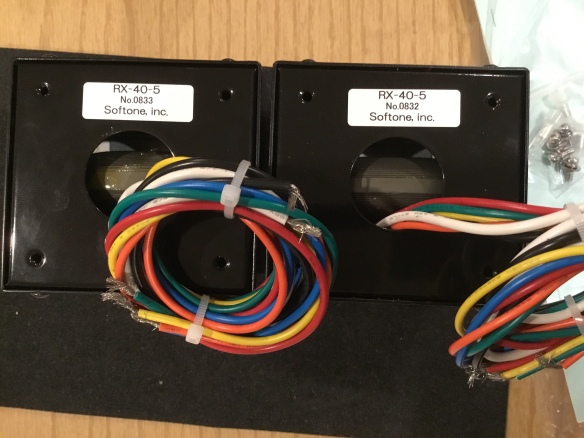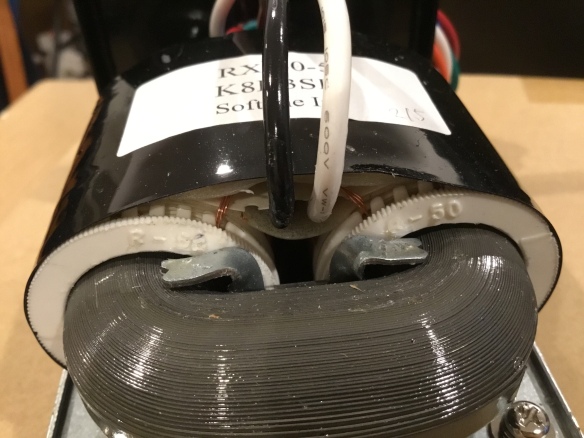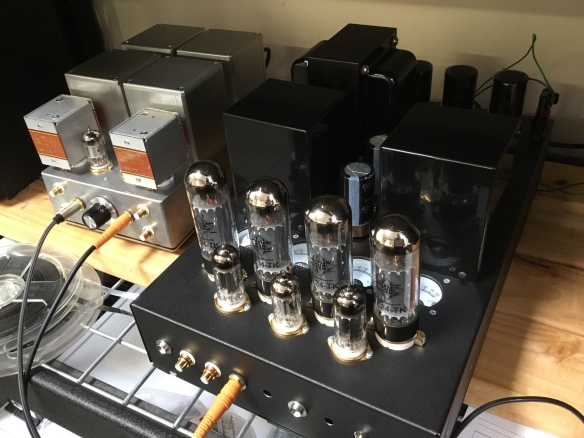Below are 2 of my 4 new R-core transformers from Japanese manufacturer Softone. Shoichi sent them the fastest I’ve ever received any online purchase from Japan: I had them in hand in 24 hours flat. The downside is that I wasn’t prepared with a chassis, choke, or power transformer parts when they arrived. I’ll talk more about my new transformers in a little bit.

I have had to learn a great deal of information about physics, materials science, chemistry, and manufacturing in order to change my career from full time cannabis farmer to electrical engineer and designer. I am proud of this. The most recent example is my new understanding of transformers and magnetics in audio circuits. The basics of power transformers are actually simple enough but like every subject in electronics, the concepts get more complicated the more you intend to try to find an “ideal” (i.e. closest to the non existent and theoretically perfect) component. Then there’s always the “taste” of designer and customer to consider: some people like one thing, other people like another. Inefficiency and flaws in components, especially transformers, impart character to the music. Although to some this may be undesirable, to others, it may be “the sound” they’ve been searching for.
I usually use EI core transformers, which are the traditional way a transformer is made for tube audio application. I have read enough about the audio industry in Japan, where there are always interesting new things happening, to have heard about R-core transformers. I knew about toroidal transformers already, but not R-cores. Toroids offer an improved efficiency over EI core transformers, which means much higher current at much lower temperature and weight levels than their EI counterparts. To explain how I’d have to get way into magnetic circuitry, but it all goes back to “losses” in transformers. All transformers experience loss when they’re used. The loss is the amount of energy being expelled as heat through the core and the copper. The traditional EI cores suffer core losses that can be 50% of total power lost. Meaning that EI cores get HOT when they’re being used. I can confirm this: the Godzilla amplifier’s power transformer sits “comfortably” at 65*C, which is damn close to too hot for comfort. A similar toroid would be smaller, lighter, and create less heat while in use. The donut shaped core of the toroid also means less stray magnetic flux escaping the transformer as well. Below is one of 4 R-cores removed from its case.

The photo above is a great look at the core material that R-cores use: it’s shaped like a toroidal core, but unlike a toroidal core, it’s made of an amorphous metal strip wound around itself to create a toroid-like layered ribbon core. The advantages of this R-core over traditional toroidal core are less weight, less stray flux, smaller, and more efficient transformers. The amorphous R-Core material is also more permeable to flux, and has a higher flux density than Si steel, reducing size necessities again. The EI cores often have a somewhat restricted frequency response, whereas toroids and R-cores usually have responses below 20hz to hypersonic frequencies. The toroid and R-core are more susceptible to imbalance between windings effecting their inductance, but as long as designers account for that in the process of construction and maintenance the toroid and R-core seem to be the superior choice for tube audio design. Eddy currents, which cause heat loss in core material, are fairly large in EI cores compared to toroids and R-cores. The R-cores especially have very low magnetostriction and relatively small eddy current losses due to their very thin core material (usually .5mm or so.) Below is a photograph of one of the R-cores where the ribbon of amorphous metal is fully visible, with it’s end point soldered down and covered with laminate.

Below is an amp I made using only EI cores. EI cores have advantages. They’re usually relatively cheap. They are also almost always Si steel cores, as Si steel has low coercivity and hysteresis when used as a magnetic component. The Si steel core output transformers are almost universally air-gapped, so as not to saturate under the presence of DC current in the windings at idle. The exception would be “amorphous” metal EI core transformers, some of which are not air gapped, and need to be used in a parafeed-style output stage due to their intolerance to DC current. Most affordable EI cores are Si steel, not amorphous metal, which can cost a ton. There are also permalloy cores, usually containing Nickel these days, which have their own character. I personally love the sound of Nickel permalloy core transformers from Coil Audio.

If you’re new to building amplifiers, go with the traditional first: use EI cores from Hammond or who ever and just follow the schematics, learn your curve math, bias math, the logic that accompanies them, etc. It’s not too hard when you’re just doing it. You’ll have to modify designs and rethink stuff as you go, but dive in.
Once you’ve had a little experience with the transformers used in tube circuits, you can see the advantages of the EI cores being their ease of acquisition and low cost generally. You’ll also see the power transformer of any class A device getting very hot from the copper loss, core loss, and eddy current loss in the power supply. These drawbacks to the Si steel EI transformer are evident in their roles as output transformers as well: they tend to have more power loss from the core and copper than a toroidal transformer, a C-core, or an R-core and have a comparatively constricted frequency response too. If one can build amplifiers with nothing but toroids, R-cores, and C-cores, the result will always be more efficient than the same design using EI core transformers.
Does an increased amplifier and transformer efficiency result in a better listening experience?
Only time, taste, and experimentation will tell. Thus far to my ear the answer has been yes, but it should be said that as one gets into better and better quality components and circuits, “character” the listener enjoys can be disrupted or completely disappear. The real answer is, only the listener and designer can tell for sure.
______
Update: August 9 2019
After listening to the R-Cores for a week or so, in different output configurations, I can say: yes, they do sound better than E+I cores I buy from Edcor. They’re very clear and responsive to the music, with a tight and articulated bass that is gently and evenly heard through the rest of the frequency palette. Edcor is still cheaper, with far less carbon emitted to produce each product, but damn these R-cores sound good. Definitely worth the 150$ each price tag.
They also have a novelty in that they are so uncommon in the USA at this point that other audiophiles I’ve met instantly express an interest in hearing them.
These R-cores are probably going to become my new go-to transformers.
Below is a photo of some testing I’ve done with my Mrantz 8BK unit

